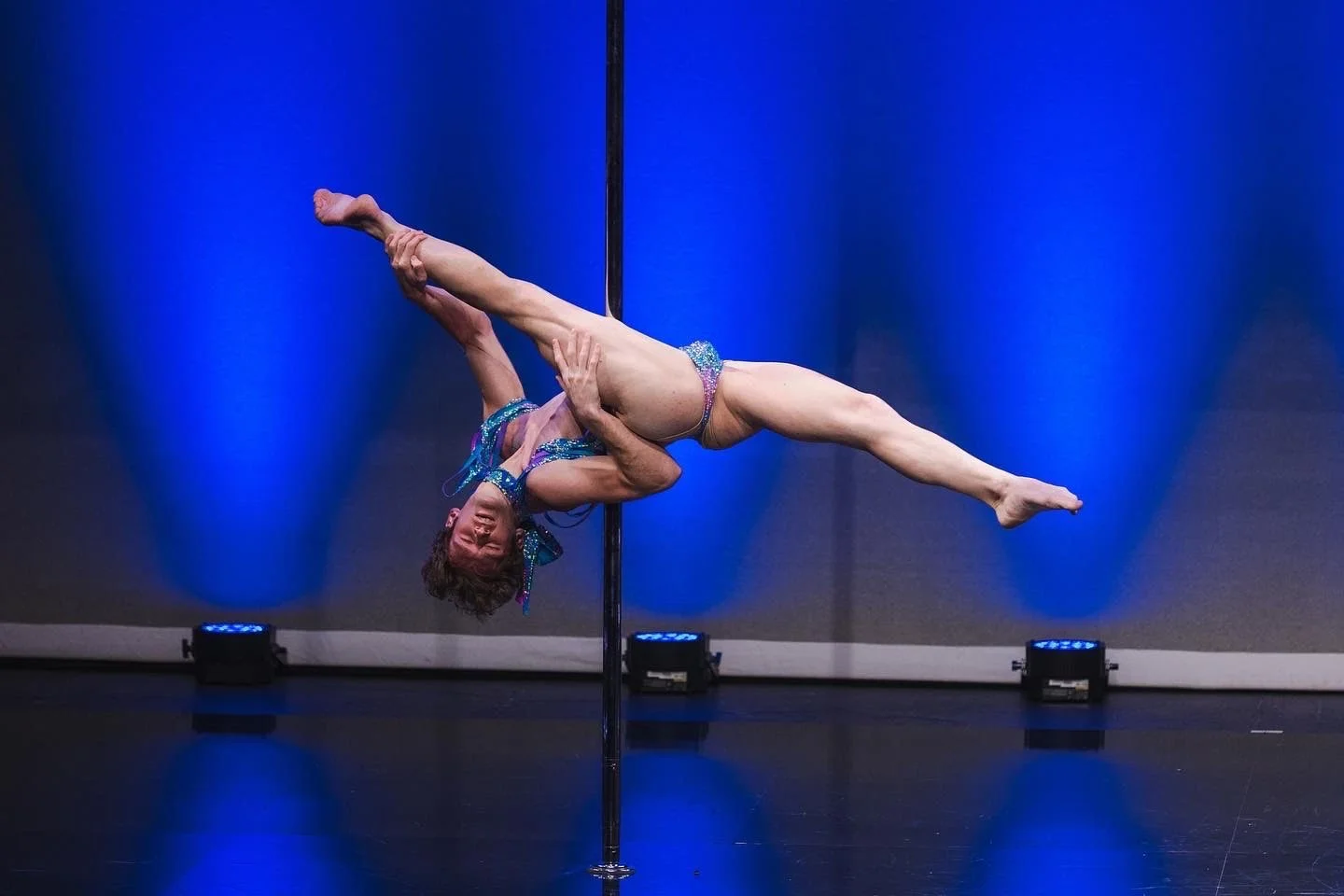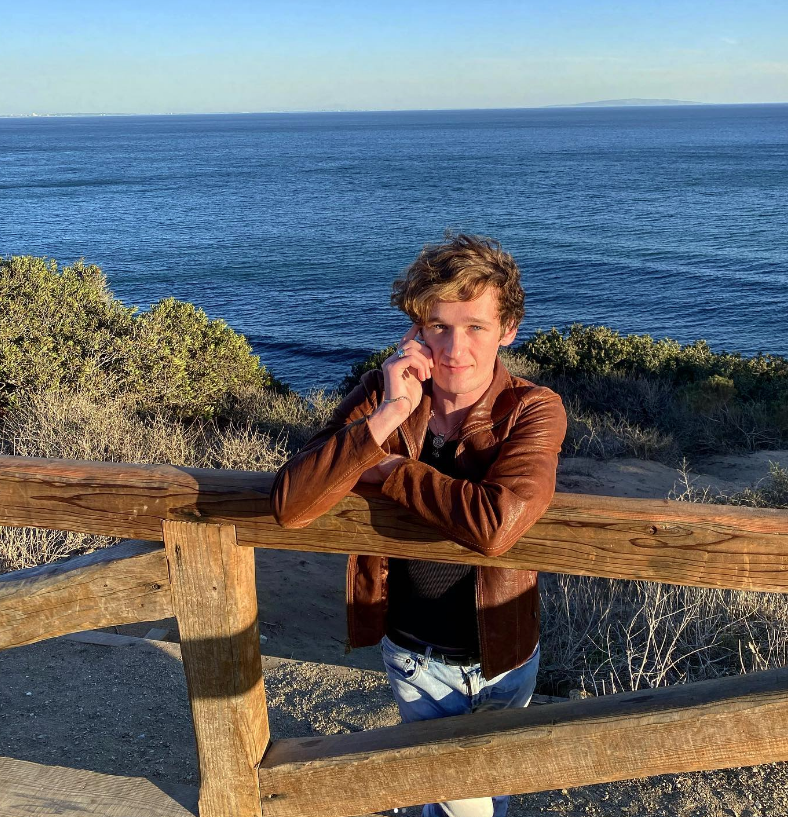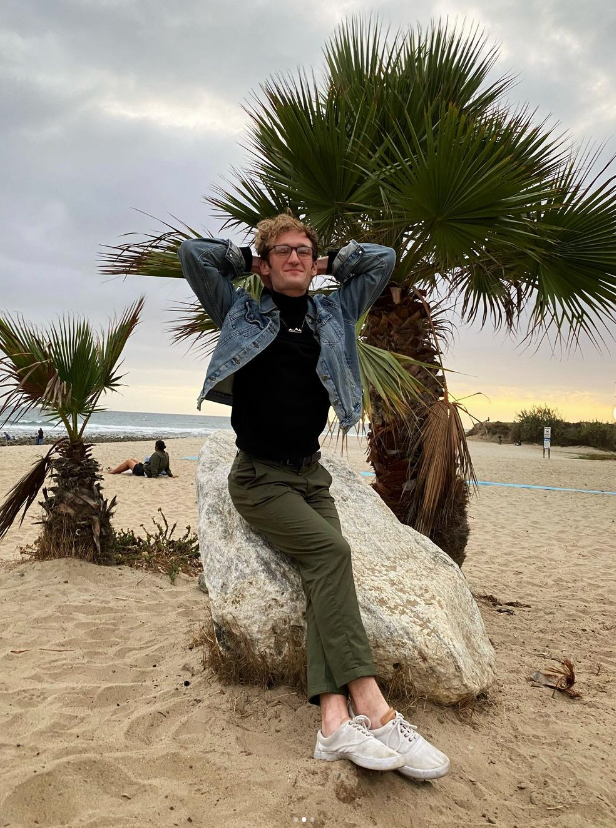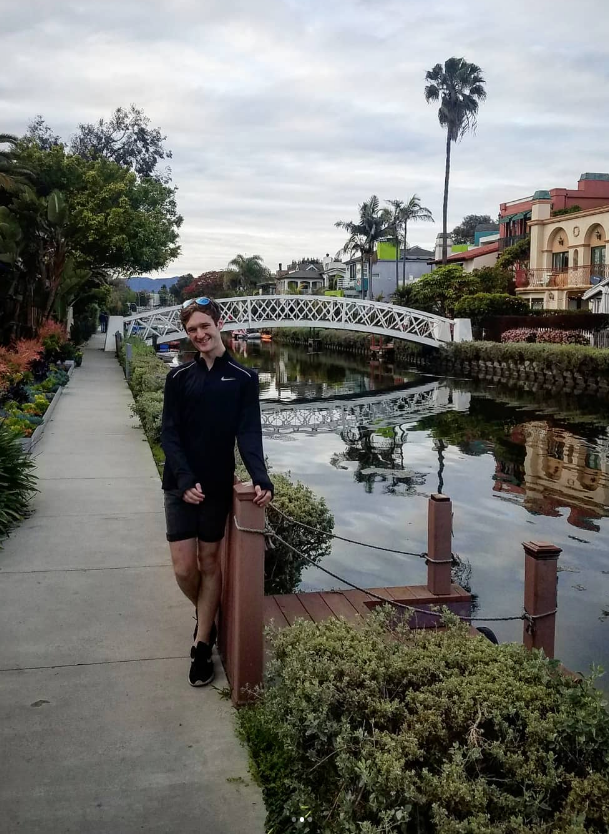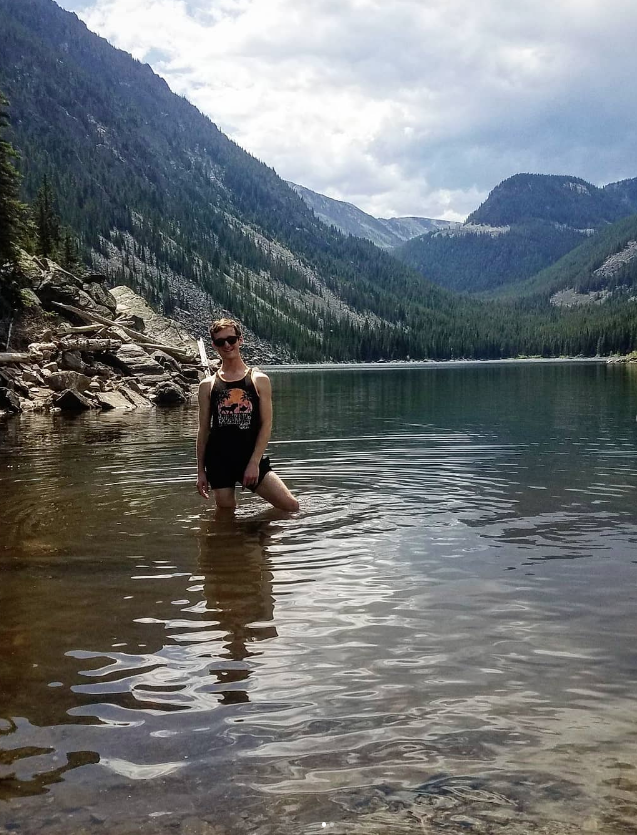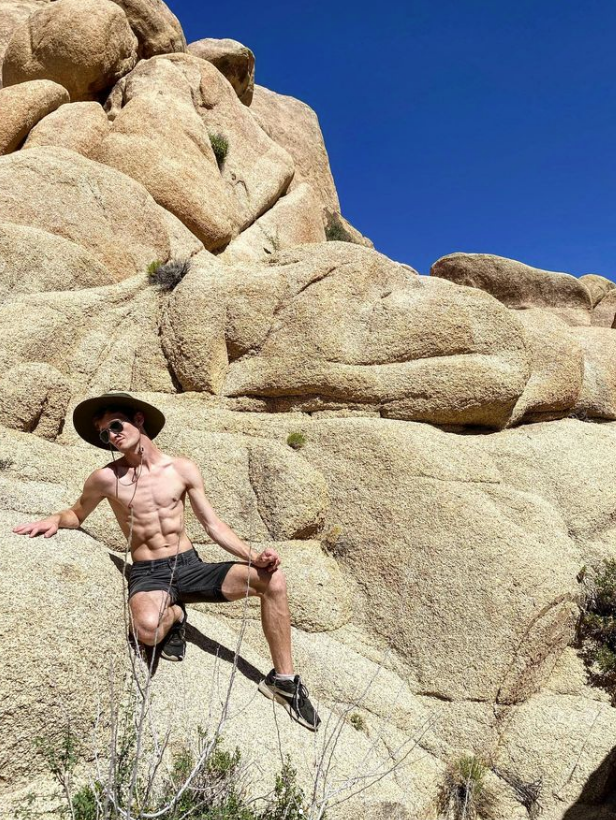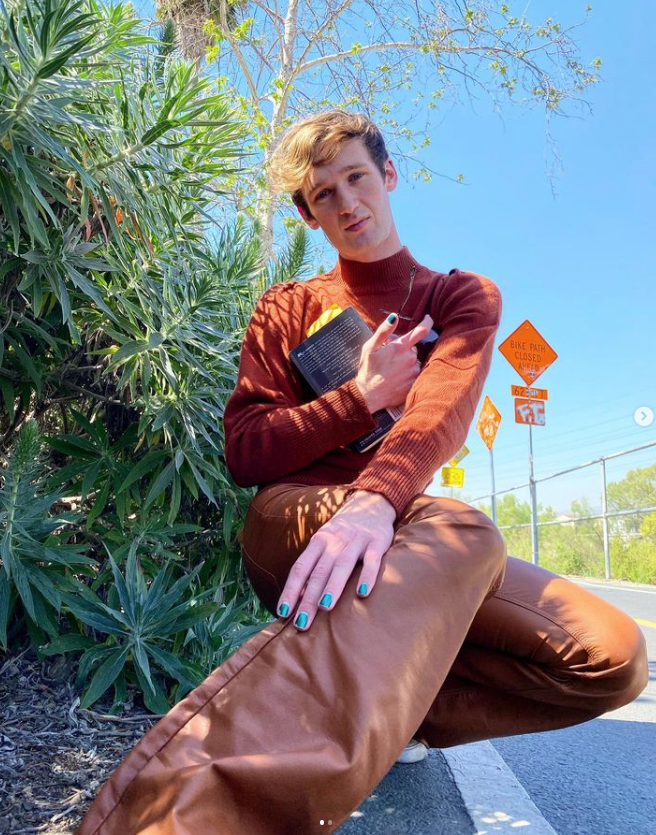Dancer mixes art and athletics
Logan Dane Johnson competes in a Pole Sport Organization event. Photo submitted
By Tom Victoria
Logan Dane Johnson is a living work of art, bringing creativity to modeling, acting and pole dancing.
The California resident stuns people with his choreography and athleticism in pole dancing, which has moved from clubs to competitions and events.
Logan, 26, of Los Angeles, explained pole dancing possesses a therapeutic value for those who enjoy doing it.
“It attracts a lot of people, myself included, who come from other walks of life and have been very hard on themselves and need to find something to relieve these preconceived notions we have about ourselves,” he said. “And prove we can be athletic and can be graceful and sexy. And its really fun, especially in the beginner classes to watch people as their self-confidence soars.”
Logan enjoys the scenery at Point Dume in Malibu, California. Photo submitted
Logan cited the physical benefits of pole dancing, which requires a unique exertion on the body.
“Even other forms of dance don’t access a lot of the other muscles pole dancing does,” he said. “It’s really fun. I absolutley love it.”
Logan would know as he formerly did ballet, jazz dancing and musical theater.
Along with performing and competing, Logan is a pole dance instructor at two studios: Bespun and Aeriform Arts.
“I mostly teach beginner classes,” he said. “I am really loving teaching. It’s really fun to watch these students come into the studio and fall in love with themselves again because pole dancing is so, in America, avant-garde.”
His training extends throughout the week.
“I would say I technically overtrain,” Logan said.
Logan performs on stage. Photo by Draco Gua
He explained his regimen, 11 hours a week in total, is what other dancers do when training for competitions. In addition to taking and teaching classes, Logan trains another two hours alone.
“You’re not supposed to train that hard unless you’re in competition,” he said. “Any beginner reading this: three classes a week is a really good place to stick. People should be going to the gym and performing other forms of art to avoid injuries. I’m just very much addicted to it and I also am enjoying working a lot.”
Logan was a ballet dancer in 2017 when he was hit by a car, dislocating multiple joints.
“Luckily, didn’t break anything,” he said.
However, the accident impacted Logan for ballet.
“I couldn’t do ballet at the level I wanted to, so I tried pole classes and really fell in love with it,” he said.
Logan also teaches pole dancing. Photo by Jordan Service Photography
Logan’s new abode was close to both studios where he now teaches.
“Bespun is one of the oldest pole studios in America,” he said. “Both of these studios are well known for incredible dancers to come out of them. The owners are lovely. I just happen to live close to them. It’s why I took classes there and now it’s my whole life.”
There are various type of pole dancing.
“There’s Contemporary Pole, which is usually barefoot and revolves around strength and endurance and making shapes in the air and on the floor,” Logan said.
Another is Old School Exotic, which relies on more exotic slow-flowing sensual choreography.
“This is the style most people think of when they think of a traditional strip club,” Logan said. “Russian Exotic is a specific style of exotic choreography based on using fast-paced extreme strength tricks and contortion.”
Logan stands at a vantage point by the Golden Gate Bridge in San Francisco. Photo submitted
He stressed unlike some athletic endeavors, pole dancing is for everyone.
“There’s an entry point for everyone no matter where you are in pole or where you are in other walks of life especially now more than ever,” Logan said.
Though that wasn’t always the case.
“It seemed initially geared towards people with dance backgrounds or people who were very fit,” Logan said. “Since it gained such a popularity especially in the pandemic, there’s a big push to make it beginner friendly. If it’s a good studio, the teacher should be able to meet you where you are in the room.”
He emphasized learning pole dancing will improve the dancer’s fitness.
“I was always in good shape,” Logan said. ”I definitely would say, currently, I’m in the best shape I’ve ever been in because of teaching pole.”
Logan savors the choreography of pole dancing. Photo by Jordan Service Photography
He recalled starting out at his first class as a student with significantly less upper-body strength.
“I could not haul my ass up the pole,” Logan said. “I couldn’t. Now, sometimes, I barely touch the floor.”
A prospective pole dancer also doesn’t need superb balance and flexibility at the start.
“We’ll get you there,” he said.
Dancers also have to become acclimated to the spinning.
“You’re going to take a little bit for your inner ear to get used to that,” Logan said, referring to the part of the body dealing with balance.
Conditioning the nerves is another facet of pole dancing.
“I never knew I could have that much pain on my ankles,” he said.
Logan visits the Santa Monica Pier. Photo submitted
Logan described how dancers have their ankles one side of the pole while their torsos straddle the other.
“After a while, the pain isn’t really much there anymore,” he said. “I forget what this feels like when you’re trying a new shape you haven’t done before.”
Logan addressed a pivotal aspect to the art form — the outfits.
“Why we wear so little clothing? One, it’s fun. Two, there are a lot of shapes, especially in the air, that require skin to grip the pole,” he said. “This art form was invented by strippers who, by trade, don’t wear a lot of clothing, and they took advantage of that while developing the art form. In many of the shapes, it’s the friction of your hips and thighs against the metal that is holding your body up there. You want to have as much surface area as possible. It’s also fun to really wear what makes you feel comfortable and sexy while you’re flying for a little bit.”
Logan employs strength, balance and flexibility to create art. Photo by Jordan Service Photography
Logan said platform shoes are not the liability one would think.
“The shoes are fun,” he said. “The shoes are an addiction for sure. A lot of the choreography, you’re holding yourself with arms on the pole to make the illusion you’re floating. It’s more beneficial to have a higher heel and higher platform because of the resulting less risk of your toes dragging on the floor. There’s more surface area to quite literally balance on the platform almost like a point shoe in ballet.”
The artist said the effort required for pole dancing is worth it.
“It takes work and dedication to yourself, definitely,” Logan said. “But I also think the pole community itself is a very welcoming community. It draws a lot of people who are looking to rediscover something about themselves whether it’s getting into shape or getting in touch with their sexual side. Because that’s part of it, too. Or getting in touch with their artistic side.”
Logan stops at Topanga Beach in Los Angeles. Photo submitted
Logan appreciates that art.
“I love choreographing a good old sexy routine,” he said. “It’s one of my favorite things to teach. I also love doing more the contemporary modern dance side.”
Logan also commended another aspect to pole dance.
“We tend to bring in a lot of people to heal,” he said. “I would say heal parts of themselves, at least I was. It creates a really welcoming environment and and a really wonderful connection with people. I’ve made lifelong friends I would never come across were it not for pole.”
Some of those friends are scattered across the globe thanks to connections made over social media.
“There’s a shared experience there,” Logan said.
Logan performs an upside-down maneuver. Photo by Jordan Service Photography
He said pole dance is a positive community due to the camaraderie.
“There’s not that sense of competition that happens in a lot of other fitness regimes,” Logan said. “It’s friendlier.”
He pointed out there’s still a misconception that pole dancing is restricted to clubs, when, in fact, there are competitions and circus events among other venues.
“Some dancers prefer to work in clubs, some dancers only work in studios and compete,” Logan said. “I do both. You can live in both worlds. And that’s a very healthy way to live.”
He said no matter where you dance, it’s important to recognize the women, often women of color, who invented the dance form while working in strip clubs.
“Without strippers, we would not have this art form,” Logan said.
Logan visits the Venice Canal Historic District in L.A. Photo submitted
Following the accident, he opted to pursue being an actor.
“I started focusing really hard on acting,” Logan said.
The Montana native relocated from Illinois in 2019 for that purpose.
“I moved to L.A. for acting and modeling,” he said.
But the pandemic hit, removing those opportunities.
“That was no longer possible at all,” Logan said. “I said what is the thing that makes me happiest in life and that was pole dancing, so I got back into it.”
He currently focuses his acting and modeling efforts on independent queer films and independent queer art.
“I really love doing art modeling and any sort of creating art with my body, creating images you wouldn’t normally see,” Logan said.
Logan uses platform shoes to prevent his feet from dragging. Photo by Jordan Service Photography
He also is a singer tied to his musical theater days.
“I still sing for fun,” Logan said.
He also reviews queer books on YouTube and skis.
“I actually grew up skiing,” Logan said. “We grew up in the mountains. It was really lovely.”
He said dance is important to him in multiple ways.
“It’s very meditative,” Logan said. “It’s very wonderful.”
I never felt so in control of my body as when I’m on the pole. Dance is requiring our body to, in any way, express something that’s happening internally we could not use words for.”
He savors time on the pole so much that he added one at home.
“It’s made my mental health so much better,” Logan said.
Logan stands in Montana's Lava Lake. Photo submitted
He works a corporate job from home. Now, the dancer can clock off for a break and execute a move on the pole for stress relief.
“Dance has always been my emotional release,” Logan said.
He plans to be dancing full-time by the end of next year.
Others are recognizing Logan’s amazing talent. He won a competition last March and placed second in one last year. He will be competing again in the spring of 2024.
Logan also is dancing with two weekly shows in L.A., Booty Burlesque and Polemasters Playhouse.
He said his family is supportive of his pole dancing.
“They were trepidatious at first,” Logan said. “But when they saw the performance, they were like ‘Oh, that was really cool and not what we expected from it.’ My parents are super proud.”
He was 18 upon realizing he wasn’t straight.
“It was a huge surprise to me,” Logan said.
Logan hikes in Joshua Tree National Park. Photo submitted
He felt uncomfortable, especially living in a small town.
“There was a lot of shame involved and a lot I had to work through,” Logan said.
He said pole dancing was a boon in that regard.
“Pole dance gave me a way to reground myself in my body and reacquaint myself with aspects of myself I had been ignoring for so long,” Logan said. “It gave me a way to explore my sensual and sexual side but also my athletic side. It allowed me to explore artistic sides of myself I never thought possible.”
As a teacher, he stresses the importance of inclusivity in pole dance.
“It’s very much a safe haven for the queers,” Logan said.
He said his classes are open to those of any orientation, including people transitioning.
“It’s important to have positive representation,” Logan said. “It’s important to have someone who knows what you’re going through. I want them to see it’s okay to involve who you are as a person into your art form. As a queer-presenting male, I’m not a stereotypical male athlete. I want people to see there are other options for people who aren’t stereotypically athletic or also not stereotypically the ballet dancer boy for dance. There are just other options creatively.”
Logan also reviews books. Photo submitted
Logan encouraged others to not feel too inadequate to pole dance.
“There’s a place for you and if you think there isn’t, there is,” he said.
Logan doesn’t have to worry about lacking motivation to dance or teach.
“I don’t have days where I don’t feel like it because I think teaching has a lot to do with that,” he said.
Logan said he reaps the benefits of endorphins generated from dancing while teaching provides ample motivation by seeing students learn to express themselves.
“What it feels like to feel empowered through your own body and your own athleticism is a really wonderful thing,” he said. “My students definitely get me out of my bed.”
Logan hopes to be able to pole dance for some time to come, unlike some other forms in which a performer may have to retire by their late 20s.
“I feel very lucky to be able to do it.”
Logan’s Instagram: https://www.instagram.com/the_logan_d/
Logan’s YouTube channel: https://www.youtube.com/@thebibookboy794/featured


